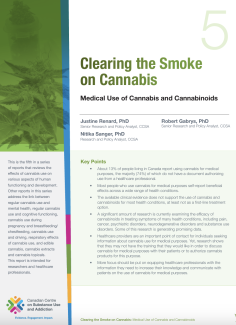
Search
Treatment
Applying interventions designed to reduce and manage the symptoms of substance use disorders.
Substance Use Disorder Treatment Quality Standards in Lithuania 1992–2022: From Grassroots Initiatives to Nationwide Strategies
BACKGROUND:
The implementation of quality standards in the treatment of substance use disorders in Lithuania is not well documented in the literature.
AIMS:
To describe the process of the development of quality standards from...
Implementation of Quality Standards in Drug Demand Reduction: Preliminary Findings from the FENIQS-EU Project
INTRODUCTION:
Quality Standards (QS) are an important priority in European drug policy, although the extent of their application remains unclear. The FENIQS-EU project (Further ENhancing the Implementation of Quality Standards in drug...
Bi-Monthly Webinar: ISSUP Nigeria Knowledge Update Series (22nd Session)
Prevalence, correlates, and reasons for substance use among adolescents aged 10–17 in Ghana: a cross-sectional convergent parallel mixed-method study
Background:
In Ghana, substance use among adolescents poses significant risks to their health, wellbeing, and development. However, little is known about the outlets and reasons for substance use among Ghanaian adolescents. This study...
Liver stiffness and associated risk factors among people with a history of injecting drugs: a prospective cohort study
Background:
People who have problems with using opioids or other drugs and inject them have shorter lives than most people. Liver diseases, especially, contribute to this. Checking liver stiffness might help find liver problems early...
Trauma exposure across the lifespan among individuals engaged in treatment with medication for opioid use disorder: differences by gender, PTSD status, and chronic pain
Background
There is little research on lifetime trauma exposure among individuals undergoing medication treatment for opioid use disorder (MOUD). A multisite study examined the prevalence of lifetime trauma and explored differences based...
A qualitative study of experiences with physical activity among people receiving opioid agonist therapy
Background
Physical or mental health commorbidities are common among people with substance use disorders undergoing opioid agonist therapy. Exercise provides many health benefits and can be used both as a preventive and treatment...
Understanding Substance Use: Educator's Guide
The guide, co-developed by the Canadian Centre on Substance Use and Addiction (CCSA) and several school boards, aims to equip educators with knowledge and resources to promote well-being and reduce substance-related harms among youth.
...
Clearing the Smoke on Cannabis and Cannabinoids: Medical Use of Cannabis and Cannabinoids
The report, "Clearing the Smoke on Cannabis: Medical Use of Cannabis and Cannabinoids 2024 Update," examines the medical use of cannabis and cannabinoids, emphasizing their effects, efficacy, and the need for more rigorous research. Key...
Alternatives to Incarceration (ATI) Reading List
Alternatives to Incarceration (ATI) encompass multi-sector approach on strategies and programs designed to divert individuals with substance use disorders away from conventional imprisonment. These alternatives address treatment, support...
National Chapters Advisory Committee Maiden Webinar: Utilising ISSUP Online Resources
On 17th April 2024 the ISSUP National Chapters Advisory Committee hosted its maiden webinar, “Utilising ISSUP Online Resources” for National Chapter focal points. The 60-minute virtual session held in both English and Spanish offered an in...
Trauma exposure across the lifespan among individuals engaged in treatment with medication for opioid use disorder: differences by gender, PTSD status, and chronic pain
Background: Limited research has been conducted on lifetime trauma exposure among individuals undergoing medication treatment for opioid use disorder (MOUD). A multisite study provided an opportunity to investigate the prevalence of...
A qualitative study of experiences with physical activity among people receiving opioid agonist therapy
Background:
Many people with substance use disorders undergoing opioid agonist therapy often have physical or mental health commorbidities. Exercise is recognised as beneficial for both prevention and treatment of various health...
Trauma exposure across the lifespan among individuals engaged in treatment with medication for opioid use disorder: differences by gender, PTSD status, and chronic pain
Looking Back: A retirement interview with Jeff Lee
Join the Power of Collaboration! Sumate al Poder de la Colaboración!
Substance Use Disorders and Oral Health
Drug Demand Reduction Workforce Credentialing - Grant Opportunity
Deadline: June 4, 2024
Overview: The Bureau of International Narcotics and Law Enforcement Affairs of the U.S. Department of State announces an open competition for organizations to submit applications to carry out a project to encourage...
Neonatal Abstinence Syndrome and its Specifics at Temporary Foster Care Institution in the Czech Republic: Study Protocol
INTRODUCTION: Neonatal Abstinence Syndrome (NAS) is a condition unique to a newborn that results from the abrupt cessation of chronic intrauterine drug exposure following birth. Slightly persistent, late onsetting, or slowly fading-out...
Substance Use Disorder in Afghanistan: The Situation and Needs to Address the Issue
INTRODUCTION: More than four decades of war and tragedy have destroyed most of the public infrastructure in Afghanistan. Currently, drug use is a major public health crisis in the country and drug treatment services have extremely limited...
Share the Knowledge: ISSUP members can post in the Knowledge Share – Sign in or become a member









